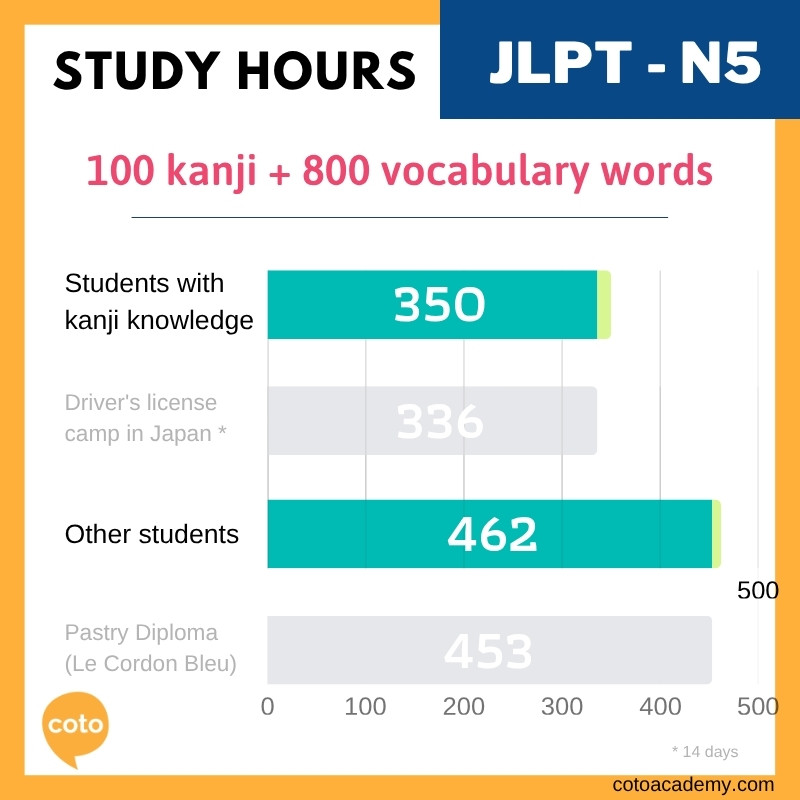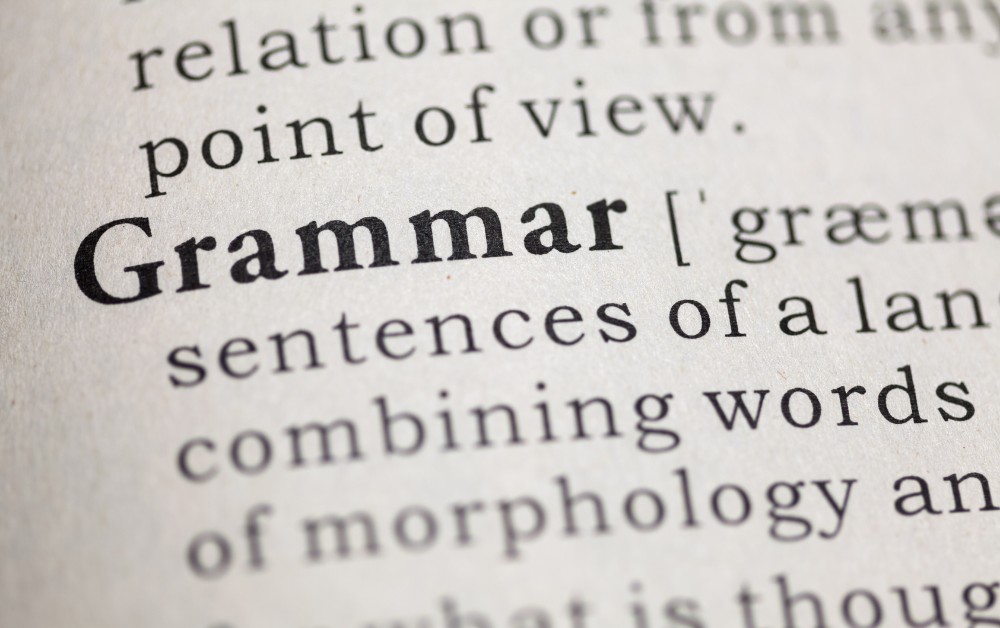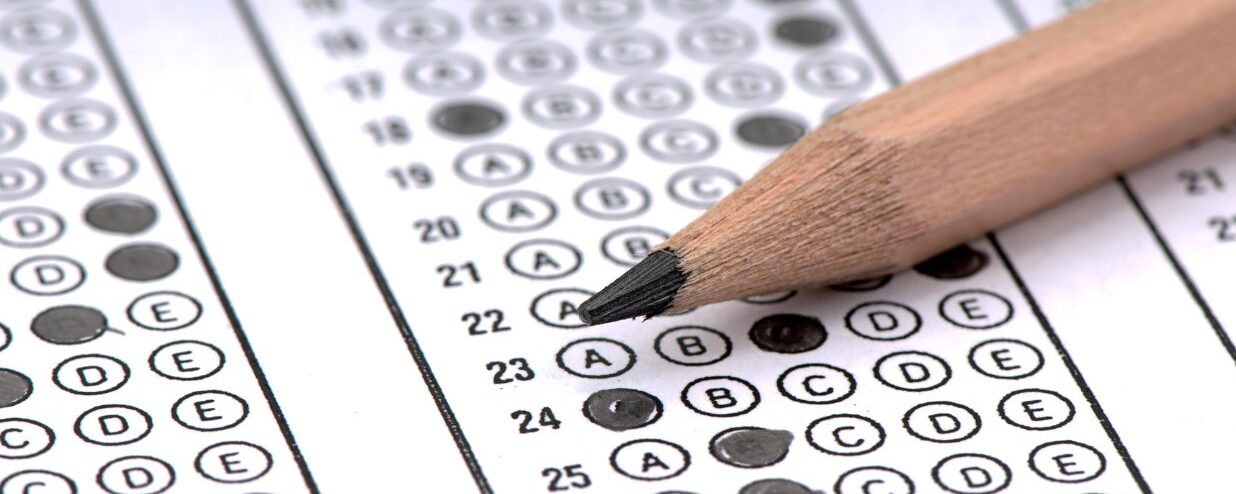Planning to take the JLPT N5? Although it is technically the lowest level a foreigner can take, the N5 can be a great milestone for those who want to see if they have made real progress. Understandably, the thought of taking the JLPT is stressful, with so many things to learn and consider. So, where do you start?
Good news is you are in the right place! In this guide, we will cover everything you need to know about the JLPT N5 exam (test contents, length, scoring methods), how to register, how to prepare, what happens on test day, and some resources and lessons we offer at Coto Academy to help you through your studies.
Want to take your JLPT preparation to the next level? We have in-person and online JLPT courses taught by our experienced Japanese instructors to help you ace your next JLPT exam!
- In-person: JLPT Prep Course.
- Online: JLPT Prep Course
What is the JLPT?
JLPT stands for Japanese Language Proficiency Test, also known as 日本語能力試験. As the name suggests, the exam measures and certifies the Japanese proficiency of non-native Japanese speakers and is used by universities and employees inside and outside Japan. It is normally carried out twice a year in Japan and is also available in certain other countries. JLPT Exams are often taken by Japanese learners planning a future in Japan!
Check out our guides for other JLPT levels as well:
- Ultimate Guide to Passing the JLPT N1 Exam
- Ultimate Guide to Passing the JLPT N2 Exam
- Ultimate Guide to Passing the JLPT N3 Exam
- Ultimate Guide to Passing the JLPT N4 Exam
- How to Study for the JLPT
What are the different levels of the JLPT?
The JLPT is divided into 5 different levels: N1, N2, N3, N4, and N5, with N1 being the most advanced level and N5 being the most basic.
- The N4 and N5 tests you on basic Japanese that you can often learn in a classroom environment
- The N3 acts as a bridge between N4/N5 and N2/N1
- The N2 and N1 tests you on a wider spectrum of Japanese knowledge used in various situations in everyday life
Who should take the JLPT N5?
While JLPT is the most widely recognized standardized Japanese test, the JLPT N5 is often not enough to help you find employment. Still, the exam can be a viable first goal for beginner Japanese learners. You can set it as a short-term target. By taking the N5 Exam, you may be able to discover your strengths and weaknesses and pursue your studies more efficiently thereafter.
Addiionally, JLPT N5 has recently become more necessary when applying for certain types of student visas. In some cases, it is actually required that you have a JLPT N5 certificate before you can study in Japan!
If you’re seeking employment in Japan, holding JLPT N2 or, even better, JLPT N1 certification will give you a major advantage. Employers often grant preferential treatment to candidates who have passed N2 or N1, and N1 holders in particular can unlock the best opportunities.
What does the JLPT N5 test?
Generally, the JLPT N5 tests you on the understanding of some core basics of Japanese, including your ability to read and comprehend elementary expressions and sentences expressed in hiragana, katakana, and some kanji. You also need to be able to listen and comprehend typical, slow-spoken conversations abundant in everyday life and in classroom environments.
What are the different sections of N5 Exam?
The JLPT N5 Exam consists of three main sections. Each of the three sections tests you on different aspects of the Japanese language.
| Section | Question types |
| 1. Language Knowledge (Vocabulary) | – Kanji reading – Orthography – Contextually-defined expressions – Paraphrases |
| 2. Language Knowledge (Grammar) and Reading | – Sentential grammar 1 (selecting grammar form) – Sentential grammar 2 (sentence composition) – Text grammar – Comprehension (short passages) – Comprehension (mid-length passages) |
| 3. Listening | – Task-based comprehension – Comprehension of key points – Verbal expressions – Quick response |
What is covered in the JLPT N5 Exam?
For all of the above three sections, you must master approximately 800 vocabulary words and 100 kanji. The 800 vocabulary words covered in the N5 Exam will correspond to the most commonly used words in the Japanese language. The 100 kanji will cover those that are naturally used in simple daily conversations, such as those related to numbers, time and days of the week, family members, and basic verbs.
Furthermore, you must be familiar with typical grammar points such as basic particle usage (は、が、を) and basic formal and casual conjugations of verbs and adjectives for past and present tenses. Before taking the test, you should be comfortable with reading and writing short, simple sentences.
Because the JLPT Exam does not test on speaking, learners who are not comfortable speaking in Japanese can theoretically still pass, as long as they have mastered the vocabulary, kanji, and grammar covered on the N5 Exam. (However, Japanese conversational abilities would make life much easier if you are seriously considering a future in Japan.)
If you are living in Japan already and want to improve your Japanese speaking, there are a variety of fun ways to practice Japanese and get out of your shell!
How long is the N5 Exam?
You are given different amounts of time for each of the three test sections.
| Section | Time |
| Language Knowledge (Vocabulary) | 20 minutes |
| Language Knowledge (Grammar) and Reading | 40 minutes |
| Listening | 30 minutes |
| Total Time | 90 minutes |
In total, you are given 90 minutes to complete the JLPT N5 Exam.
What is the scoring for the JLPT N5 like?
Although the N5 Exam contains three sections, the scoring is divided into two.
| Section | Range of Scores |
| Language Knowledge (Vocabulary/Grammar) and Reading | 0 – 120 |
| Listening | 0 – 60 |
| Overall Score | 0 – 180 |
Your overall score can range from anywhere between 0 to 180.
For the N5 Exam, a passing score is anything above an overall score of 80 points. However, in addition to meeting the overall score of 80 points, you must also meet sectional pass marks of 38 points in the Language Knowledge (Vocabulary/Grammar) and Reading Section and 19 points in the Listening Section.
How long should I study for JLPT N5?

For students with kanji knowledge, like Chinese students, it takes 350 hours to pass the N5 exam. For other students who don’t have prior kanji knowledge, it takes 462 hours of studying.
These hours estimates are gathered when students self-report their estimated study time during the exam registration process. The question is added as a compulsory field.
For more information on the study hours for all levels of the JLPT, check out this blog article: How Many Hours Does it Take to Pass the JLPT – Illustrated Guide.
How to Prepare for JLPT N5
Mastering Kanji and Vocabulary
In addition to hiragana and katakana, the JLPT N5 covers around 100 kanji and 800 vocabulary words. (Of course, you do not have to know all of them to pass, but it’s impossible to predict which ones will be on the exam.)
We highly recommend that you check out our JLPT N5 Self-Study Guide.

We have also provided several of the worksheets free of charge at the links below! These are very useful as they cover many of the kanji that you will be tested on during the N5 exam.
- Unit 1. JLPT N5 Kanji – Numbers
- Unit 2. JLPT N5 Kanji – Time
- Unit 3. JLPT N5 Kanji – People and Body
- Unit 4. JLPT N5 Kanji – Nature
- Unit 5. JLPT N5 Kanji – Direction
To become familiar with the most commonly used vocabulary words likely to appear on the JLPT N5 Exam, check out our list of the Top 100 Basic Japanese Words.
Mastering JLPT N5 Grammar

Although the JLPT N5 Exam scores vocabulary and grammar cumulatively, it is recommended that you study for them independently. The grammar section of the exam tests on basic particle usage (ha, ga, wo, etc.) and formal and casual conjugations of verbs and adjectives for past and present tenses.
To learn grammar points covered on the N5 Exam, you can check out the below the articles on basic Japanese Grammar:
- Basic Japanese Grammar Guide Part I – Basic Sentence Patterns
- Basic Japanese Grammar Guide Part II – Particles (wa, ga, o, ni, de)
- Basic Japanese Grammar Guide Part III – Particles (no, to, mo, kara, made, ga)
- Basic Japanese Grammar Guide Part IV – Verbs
- 30 Must-Know JLPT N5 Grammar Points
Japanese particles can be a tricky subject, so check: Beginner’s Guide to Japanese Particles.
Mastering JLPT N5 Listening
To help you get prepared for the listening section, we have a 30-day challenge for you!
In our Free JLPT N5 30-Day Grammar Listening Challenge, you will spend 15 minutes each day for 30 days improving your listening and learning new grammar points. Each day, you will be given two phrases or grammar points and check your understanding with a flash card matching game. By the end of the course, not only will you have strengthened your listening, but you will have also learned 60 grammar points necessary to pass the N5 Exam!
Our Coto Japanese Academy YouTube Channel can be a great tool for listening practice and growing your grammar arsenal.
Although self-studying is a great way to study at your own pace, textbooks and worksheets may not perfectly prepare you for what’s to come on the JLPT Exam.
How to register for JLPT N5
Registering for the JLPT can be done online via the official JLPT website. The tests are conducted worldwide. In Japan, the JLPT is held annually in July and December. Make sure to check the official site for the list of overseas JLPT test sites.
- Application Period: The July exam application periods end in April. December exam applications end in September
- Application Method: You must apply from the MyJLPT “JLPT Application” screen after registering with MyJLPT on the JLPT website of Japan Educational Exchanges and Services (JESS).
- Test Fee: ¥7,500 yen (price can vary depending on country and test sites, so always refer to the original JLPT portal)
Payment Methods: Credit card, bank wire transfer (pay-easy), payment at a convenience store.
Once registered, you will receive a test voucher around mid-November indicating your test location and more details about the JLPT Exam.
We have provided a step-by-step guide to registering for the JLPT.
What happens on test day
Before heading out to your test center, make sure to bring your test voucher, writing utensils (mechanical pencils are accepted), and maybe some snacks and a watch to help you with time management.
For examinees in Japan, your test will begin at 12:30, but the test center will already be open from 11:45. We recommend you head out early to be safe.
Once you arrive at your test venue, you will be asked to show your test voucher to the staff. Examinees are split into different rooms based on their voucher numbers. You will be instructed to enter one of these rooms.
The whole exam will take several hours to complete (in the case of the N5 Exam, an hour and a half), and you will get short breaks between each section. When the exam is finished, you will need to wait until all test papers have been collected before you can leave the room. Check out our article on JLPT tips for the actual day.
Taking the JLPT? Join Preparation Lessons at Coto Academy!
Planning to take the JLPT? Maximize your chances of success with customized lessons at Coto Academy. Our experienced instructors have helped hundreds of students pass the exam. You’ll cover all sections of the test and practice with real mock exams based on past JLPT papers.
Spots fill up quickly. Sign up today and start your path to JLPT success!
Ready to smash JLPT N5?
FAQ
Around what level is the JLPT N5
The JLPT N5 is considered to be the most basic level of Japanese. To pass the test you would need to know around 800 vocabulary words and 100 kanji characters. The test mostly uses hiragana, katakana, and just a bit of kanji. You would also need to understand simple Japanese conversation.
How many hours of studying is needed to pass the JLPT?
While it depends on your current level and linguistic background, on average, it could take around 460 hours of study if you are starting from scratch. If your native language already uses kanji, the hours of study could be much less, around 350 hours.
Would passing the JLPT N5 have benefits for visas or getting jobs?
Passing the JLPT N5 could be considered when applying for certain work or long-term stay visas. Some roles that require a basic level of Japanese would consider the N5 certification a plus point for your application.
Is taking the N5 worth it?
The JLPT N5, while still testing a basic level, is still very valuable. It’s a great way to gauge your Japanese level and progress, which can be very motivating. It’s also an official certificate that you can use on your resume or other documents, showcasing your skills.
